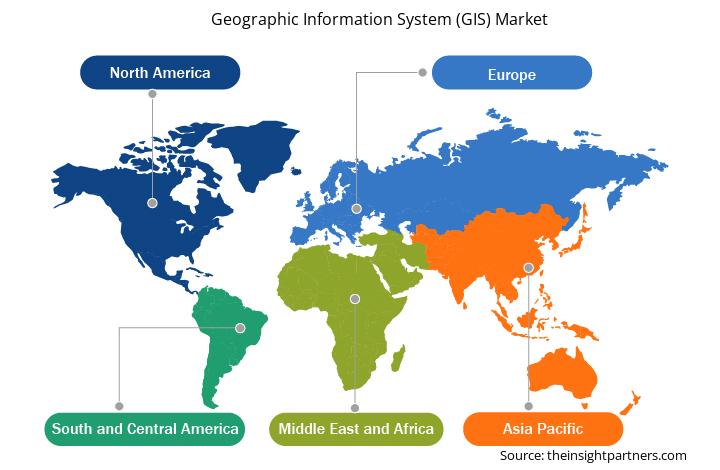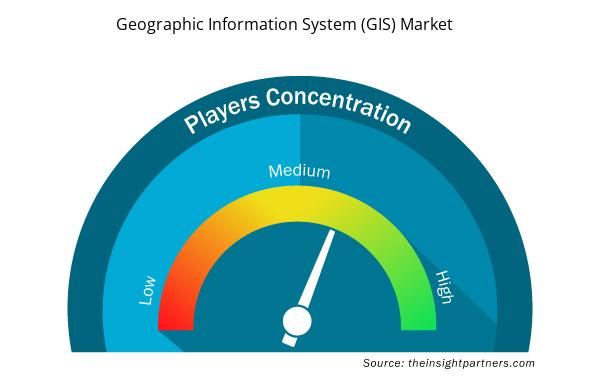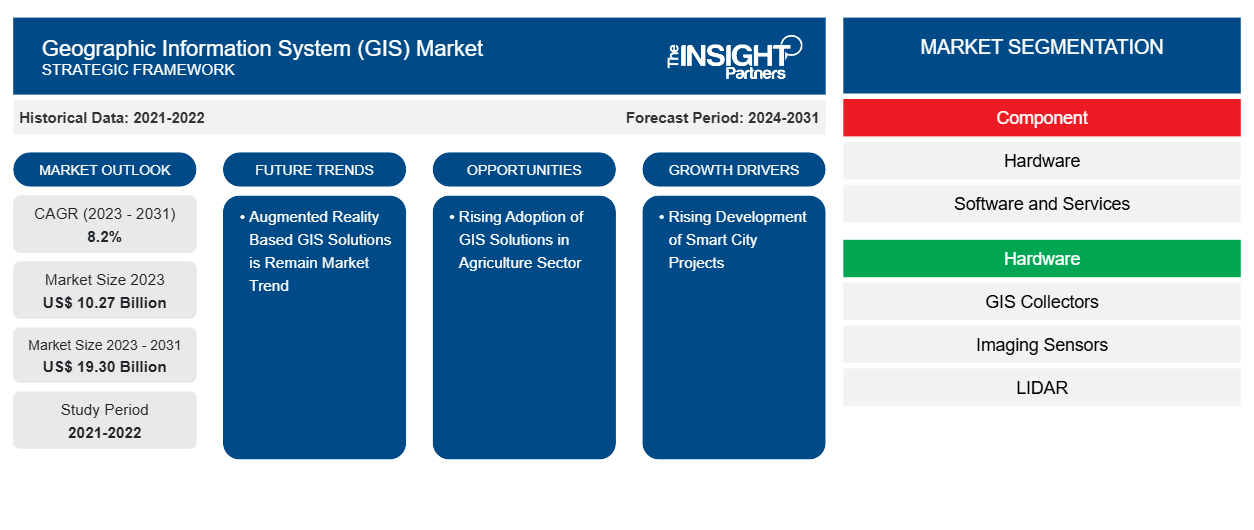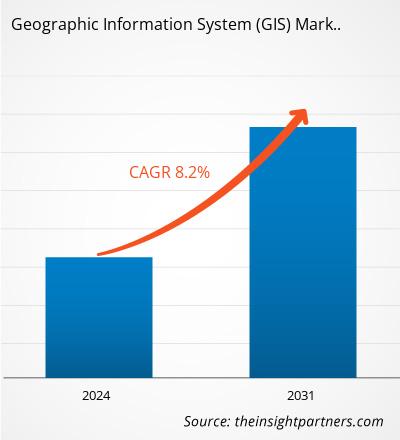地理信息系统 (GIS) 市场规模预计将从 2023 年的 102.7 亿美元增至 2031 年的 193.0 亿美元。预计 2023 年至 2031 年期间,该市场的复合年增长率将达到 8.2%。基于 AI、Gen AI 和增强现实的 GIS 解决方案的推出可能会在未来几年为市场带来新的趋势。
地理信息系统 (GIS) 市场分析
由于预测自然灾害的需求激增,预计地理信息系统 (GIS) 市场将在预测期内大幅增长。地理信息系统广泛用于准确预测风暴、飓风和过度降雨。它通过提供必要的空间数据、图像和分析,在预测和减轻此类自然灾害事件的影响方面发挥着重要作用。根据 USAFacts 组织的数据,在美国,每年记录的自然灾害超过 65,000 起。美国政府使用先进的 GIS 解决方案来预测和预报自然灾害事件。从 1980 年到 2023 年,美国记录并遭受了 400 多起与天气和气候有关的自然灾害,总损失成本超过 2.78 万亿美元。2024 年 11 月,记录了约 24 起确认的与天气有关的自然灾害事件,损失超过 10 亿美元。这些自然事件包括一次野火事件、十七次严重风暴事件、四次热带气旋事件和两次冬季风暴事件。此外,根据欧盟委员会组织的数据,在南欧,2022 年野火烧毁了 90 万公顷土地。此外,2023 年,野火烧毁了超过 50 万公顷土地——主要发生在意大利、希腊、西班牙和葡萄牙。为了避免此类自然灾害事件并减少额外的损失成本,对地理信息系统的需求日益增加。因此,预测自然灾害的需求推动了地理信息系统市场的增长。
农民使用 GIS 解决方案绘制农业田间数据并远程分析、组织和监控农作物。GPS 和 GIS 集成系统有助于收集农田作物产量、农作物需水量等实时数据。农民还使用 GIS 解决方案来提高资源利用率并分析作物品种、田地边界、海拔高度、灌溉系统等。因此,农业领域越来越多地采用 GIS 解决方案预计将在预测期内为地理信息系统市场增长提供丰厚的机会。
地理信息系统 (GIS) 市场概览
地理信息系统 (GIS) 软件用于综合大量信息,并以有用的方式帮助管理和检索数据。GIS 的各种最终用户包括物流和运输、农业、石油和天然气、建筑、采矿、能源和公用事业以及许多其他行业。GIS 可以存储、集成、编辑、共享、分析和显示地理参考信息。它允许用户创建交互式查询、分析空间信息地图、编辑数据并呈现所有这些操作的结果。GIS 技术是结合各种遥感信息和地图以生成各种模型的重要工具。GIS 软件是农业科学家通过使用地理数据和实施农业发展规划活动为农民提供更好服务的强大解决方案。
定制此报告以满足您的需求
您可以免费定制任何报告,包括本报告的部分内容、国家级分析、Excel 数据包,以及为初创企业和大学提供优惠和折扣
- 获取此报告的关键市场趋势。这个免费样品将包括数据分析,从市场趋势到估计和预测。
地理信息系统 (GIS) 市场驱动因素和机遇
物流、运输和基础设施领域对实时位置服务的需求很高
根据联合国 2022 年的报告,2023 年全球物流业价值约为 9.4 万亿美元,预计 2024 年将达到 9.9 万亿美元,年增长率为 5.3%。在运输和物流领域,地理信息系统用于实时交通监控和实时车辆跟踪。GIS 通过空间数据的可视化显示提供监控功能,并为监控车辆提供精确的地理实时定位。此外,GIS 地图解决方案被广泛用于创建新的铁路线、公路和其他运输路线。全球对公路和铁路基础设施建设的投资继续快速增长。根据《全球基础设施展望报告》,2023 年全球交通基础设施投资达到 1.60 万亿美元。地理信息系统在规划交通基础设施和管理时广泛应用于空间数据的分析和可视化。它提供了许多好处,例如提高效率、降低成本、安全性和可持续性。根据世界银行组织的数据,全球道路清单项目包含 60 多个与道路基础设施相关的地理空间数据集。该数据集涵盖约 222 个国家/地区,包括 2100 万公里道路的路线图。地理信息系统用于提取这些国家的地理空间数据。因此,物流和运输以及基础设施领域对实时位置服务的高需求推动了地理信息系统市场的增长。
农业领域日益采用 GIS 解决方案
市场上的几家主要参与者正在为农业部门开发基于先进技术的 GIS 解决方案。例如,2024 年 7 月,Ecopia AI 推出了新的农业用地数据,该数据使用矢量数据提取 3D 全国土地数据集的新级别。这些平面矢量数据层使政府机构能够执行与土地开发、用水、径流计算、税收评估和其他详细分析工作流程相关的深入地理空间分析。2022 年,该公司推出了 3D 全国土地覆盖,提供 14 个高精度 2D 数据层,用于绘制建筑物、树木、农业用地和桥梁。2024 年 3 月,Agribazaar 在印度北方邦为农民推出了一个基于人工智能的 GIS 指挥中心。该项目旨在以数字方式可视化北方邦 75 个地区 57,000 个 Gram Panchayats 的农业数据。
2024 年 5 月,GNSS 技术解决方案提供商 CHC Navigation 推出了 MapCloud,这是用于 Android 设备数据捕获和地图绘制应用程序的高级 GIS 解决方案之一。此 MapCloud 为各个行业的工程师、测量员、农民和 GIS 专业人员提供了强大的现场数据收集工具。
因此,农业领域对 GIS 解决方案的采用日益增多将为地理信息系统市场的增长提供机会。
地理信息系统 (GIS) 市场报告细分分析
有助于地理信息系统 (GIS) 市场分析的关键部分是组件、功能和最终用户。
- 按组件划分,市场分为硬件、软件和服务。软件部分在 2023 年占据了市场主导地位。
- 根据功能,市场分为地图绘制、测量、远程信息处理和导航以及基于位置的服务。地图绘制领域在 2023 年占据了市场主导地位。
- 根据最终用户,市场细分为农业、石油和天然气、建筑、采矿、运输和物流、能源和公用事业等。运输和物流部门在 2023 年占据了市场主导地位。
地理信息系统 (GIS) 市场份额分析(按地区)
地理信息系统 (GIS) 市场分为五大区域:北美、欧洲、亚太地区 (APAC)、中东和非洲 (MEA) 以及南美和中美。2023 年,北美占据市场主导地位,其次是欧洲和亚太地区。
北美地理信息系统 (GIS) 市场正在显着增长,这归因于几个关键因素,包括智能城市基础设施、技术进步和跨行业应用的增加。美国和加拿大的智慧城市计划严重依赖 GIS 来管理公用事业、交通系统和公共服务。此外,北美各国政府正在采取各种举措来增加该地区的智能电网基础设施。例如,2022 年 9 月,美国能源部 (DOE) 投资 105 亿美元用于智能电网和其他升级计划,以加强该国的电网。同样,GI 智能电网计划是加拿大自然资源部针对重要基础设施的国家计划之一,旨在推进泛加拿大清洁增长和气候变化框架的目标。智能电网计划于 2023 年续签。GIS 是一种广泛使用的智能电网技术,可实现增强监控、准确建模、数据集成、战略规划和有效沟通。
地理信息系统 (GIS) 市场区域洞察
Insight Partners 的分析师已详细解释了预测期内影响地理信息系统 (GIS) 市场的区域趋势和因素。本节还讨论了北美、欧洲、亚太地区、中东和非洲以及南美和中美洲的地理信息系统 (GIS) 市场细分和地理位置。

- 获取地理信息系统 (GIS) 市场的区域特定数据
地理信息系统 (GIS) 市场报告范围
| 报告属性 | 细节 |
|---|---|
| 2023 年的市场规模 | 102.7亿美元 |
| 2031 年市场规模 | 193亿美元 |
| 全球复合年增长率(2023 - 2031) | 8.2% |
| 史料 | 2021-2022 |
| 预测期 | 2024-2031 |
| 涵盖的领域 | 按组件
|
| 覆盖地区和国家 | 北美
|
| 市场领导者和主要公司简介 |
|
地理信息系统 (GIS) 市场参与者密度:了解其对业务动态的影响
地理信息系统 (GIS) 市场正在快速增长,这得益于最终用户需求的不断增长,而这些需求又源于消费者偏好的不断变化、技术进步以及对产品优势的认识不断提高等因素。随着需求的增加,企业正在扩大其产品范围,进行创新以满足消费者的需求,并利用新兴趋势,从而进一步推动市场增长。
市场参与者密度是指在特定市场或行业内运营的企业或公司的分布情况。它表明在给定市场空间中,相对于其规模或总市场价值,有多少竞争对手(市场参与者)存在。
在地理信息系统 (GIS) 市场运营的主要公司有:
- Autodesk 公司
- Topcon 定位系统有限公司
- 卡尺公司
- 超图软件股份有限公司
- 六角形AB
- 中海达
免责声明:上面列出的公司没有按照任何特定顺序排列。

- 获取地理信息系统 (GIS) 市场顶级关键参与者概览
地理信息系统 (GIS) 市场新闻和最新发展
地理信息系统 (GIS) 市场通过收集一手和二手研究后的定性和定量数据进行评估,其中包括重要的公司出版物、协会数据和数据库。以下列出了地理信息系统 (GIS) 市场的一些关键发展:
- GEO Jobe GIS Consulting 是 GIS 解决方案领域的知名领导者,该公司宣布与 Oriented Imagery 软件的首要提供商 AerialSphere 建立新的经销商合作伙伴关系。此次合作标志着 AerialSphere 尖端 Oriented Imagery 技术在 GIS 社区内扩大覆盖范围的里程碑。
(来源:AerialSphere,新闻稿,2024 年 7 月)
- 地理信息系统 (GIS) 技术和位置智能领域的全球领导者 Esri 与建筑、工程、施工和运营 (AECO) 行业建筑信息模型 (BIM) 技术的全球领导者 Autodesk, Inc. (NASDAQ:ADSK) 正在加强其战略联盟。
(来源:Esri,新闻稿,2024 年 10 月)
地理信息系统 (GIS) 市场报告覆盖范围和交付成果
“地理信息系统 (GIS) 市场规模和预测(2021-2031 年)”对市场进行了详细分析,涵盖以下领域:
- 地理信息系统 (GIS) 市场规模及全球、区域和国家层面所有主要细分市场的预测
- 地理信息系统 (GIS) 市场趋势以及市场动态,如驱动因素、限制因素和关键机遇
- 详细的 PEST 和 SWOT 分析
- 地理信息系统 (GIS) 市场分析涵盖主要市场趋势、全球和区域框架、主要参与者、法规和最新市场发展
- 行业格局和竞争分析,涵盖市场集中度、热图分析、知名参与者以及地理信息系统 (GIS) 市场的最新发展
- 详细的公司简介
- 历史分析(2 年)、基准年、预测(7 年)及复合年增长率
- PEST 和 SWOT 分析
- 市场规模价值/数量 - 全球、区域、国家
- 行业和竞争格局
- Excel 数据集



Report Coverage
Revenue forecast, Company Analysis, Industry landscape, Growth factors, and Trends

Segment Covered
This text is related
to segments covered.

Regional Scope
North America, Europe, Asia Pacific, Middle East & Africa, South & Central America

Country Scope
This text is related
to country scope.
常见问题
The Geographic Information System (GIS) market was estimated to be valued at US$ 10.27 billion in 2023 and is anticipated to grow at a CAGR of 8.2% over the forecast period.
Rapid development of smart city projects, surge in need for forecasting natural disasters, high demand for real-time location-based services in logistics and transportation and infrastructure sectors are the driving factors of Geographic Information System (GIS) market.
Asia Pacific is anticipated to grow at the fastest CAGR over the forecast period.
Launch of AI, Gen AI, and augmented reality-based GIS Solutions to drive the growth of the Geographic Information System (GIS) market in the coming years.
The key players operating in the Geographic Information System (GIS) market include Autodesk, Inc.; Topcon Positioning Systems, Inc.; Caliper Corporation; SuperMap Software Co., Ltd.; Hexagon AB; Hi-Target; Pitney Bowes Inc.; Maxar Technologies; AmigoCloud, Inc.; Trimble Inc.; Bentley Systems, Incorporated; Cadcorp Limited; Spatialworks Sdn Bhd.; Environmental Systems Research Institute, Inc.; Blue Marble Geographics; Abaco SpA; TomTom International BV; FARO Technologies, Inc.; L3Harris Technologies, Inc.; and Başarsoft Information Technologies Inc..
The Geographic Information System (GIS) market is expected to reach US$ 19.30 billion by 2031.
The software segment led the Geographic Information System (GIS) market with a significant share in 2023.
Trends and growth analysis reports related to Technology, Media and Telecommunications : READ MORE..
The List of Companies - Geographic Information System (GIS) Market
- Autodesk, Inc.
- Topcon Positioning Systems, Inc.
- Caliper Corporation
- SuperMap Software Co., Ltd.
- Hexagon AB
- Hi-Target
- Pitney Bowes Inc.
- Maxar Technologies
- AmigoCloud, Inc.
- Trimble Inc.
- Bentley Systems, Incorporated
- Cadcorp Limited
- Spatialworks Sdn Bhd.
- Environmental Systems Research Institute, Inc.
- Blue Marble Geographics
- Abaco SpA
- TomTom International BV
- FARO Technologies, Inc.
- L3Harris Technologies, Inc.;
- Ba?arsoft Information Technologies Inc.
The Insight Partners performs research in 4 major stages: Data Collection & Secondary Research, Primary Research, Data Analysis and Data Triangulation & Final Review.
- Data Collection and Secondary Research:
As a market research and consulting firm operating from a decade, we have published and advised several client across the globe. First step for any study will start with an assessment of currently available data and insights from existing reports. Further, historical and current market information is collected from Investor Presentations, Annual Reports, SEC Filings, etc., and other information related to company’s performance and market positioning are gathered from Paid Databases (Factiva, Hoovers, and Reuters) and various other publications available in public domain.
Several associations trade associates, technical forums, institutes, societies and organization are accessed to gain technical as well as market related insights through their publications such as research papers, blogs and press releases related to the studies are referred to get cues about the market. Further, white papers, journals, magazines, and other news articles published in last 3 years are scrutinized and analyzed to understand the current market trends.
- Primary Research:
The primarily interview analysis comprise of data obtained from industry participants interview and answers to survey questions gathered by in-house primary team.
For primary research, interviews are conducted with industry experts/CEOs/Marketing Managers/VPs/Subject Matter Experts from both demand and supply side to get a 360-degree view of the market. The primary team conducts several interviews based on the complexity of the markets to understand the various market trends and dynamics which makes research more credible and precise.
A typical research interview fulfils the following functions:
- Provides first-hand information on the market size, market trends, growth trends, competitive landscape, and outlook
- Validates and strengthens in-house secondary research findings
- Develops the analysis team’s expertise and market understanding
Primary research involves email interactions and telephone interviews for each market, category, segment, and sub-segment across geographies. The participants who typically take part in such a process include, but are not limited to:
- Industry participants: VPs, business development managers, market intelligence managers and national sales managers
- Outside experts: Valuation experts, research analysts and key opinion leaders specializing in the electronics and semiconductor industry.
Below is the breakup of our primary respondents by company, designation, and region:

Once we receive the confirmation from primary research sources or primary respondents, we finalize the base year market estimation and forecast the data as per the macroeconomic and microeconomic factors assessed during data collection.
- Data Analysis:
Once data is validated through both secondary as well as primary respondents, we finalize the market estimations by hypothesis formulation and factor analysis at regional and country level.
- Macro-Economic Factor Analysis:
We analyse macroeconomic indicators such the gross domestic product (GDP), increase in the demand for goods and services across industries, technological advancement, regional economic growth, governmental policies, the influence of COVID-19, PEST analysis, and other aspects. This analysis aids in setting benchmarks for various nations/regions and approximating market splits. Additionally, the general trend of the aforementioned components aid in determining the market's development possibilities.
- Country Level Data:
Various factors that are especially aligned to the country are taken into account to determine the market size for a certain area and country, including the presence of vendors, such as headquarters and offices, the country's GDP, demand patterns, and industry growth. To comprehend the market dynamics for the nation, a number of growth variables, inhibitors, application areas, and current market trends are researched. The aforementioned elements aid in determining the country's overall market's growth potential.
- Company Profile:
The “Table of Contents” is formulated by listing and analyzing more than 25 - 30 companies operating in the market ecosystem across geographies. However, we profile only 10 companies as a standard practice in our syndicate reports. These 10 companies comprise leading, emerging, and regional players. Nonetheless, our analysis is not restricted to the 10 listed companies, we also analyze other companies present in the market to develop a holistic view and understand the prevailing trends. The “Company Profiles” section in the report covers key facts, business description, products & services, financial information, SWOT analysis, and key developments. The financial information presented is extracted from the annual reports and official documents of the publicly listed companies. Upon collecting the information for the sections of respective companies, we verify them via various primary sources and then compile the data in respective company profiles. The company level information helps us in deriving the base number as well as in forecasting the market size.
- Developing Base Number:
Aggregation of sales statistics (2020-2022) and macro-economic factor, and other secondary and primary research insights are utilized to arrive at base number and related market shares for 2022. The data gaps are identified in this step and relevant market data is analyzed, collected from paid primary interviews or databases. On finalizing the base year market size, forecasts are developed on the basis of macro-economic, industry and market growth factors and company level analysis.
- Data Triangulation and Final Review:
The market findings and base year market size calculations are validated from supply as well as demand side. Demand side validations are based on macro-economic factor analysis and benchmarks for respective regions and countries. In case of supply side validations, revenues of major companies are estimated (in case not available) based on industry benchmark, approximate number of employees, product portfolio, and primary interviews revenues are gathered. Further revenue from target product/service segment is assessed to avoid overshooting of market statistics. In case of heavy deviations between supply and demand side values, all thes steps are repeated to achieve synchronization.
We follow an iterative model, wherein we share our research findings with Subject Matter Experts (SME’s) and Key Opinion Leaders (KOLs) until consensus view of the market is not formulated – this model negates any drastic deviation in the opinions of experts. Only validated and universally acceptable research findings are quoted in our reports.
We have important check points that we use to validate our research findings – which we call – data triangulation, where we validate the information, we generate from secondary sources with primary interviews and then we re-validate with our internal data bases and Subject matter experts. This comprehensive model enables us to deliver high quality, reliable data in shortest possible time.


 获取此报告的免费样本
获取此报告的免费样本